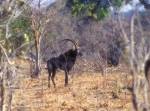|
Africa shelters a great number of species of antelopes,
their size spanning between from that of a rabbit (dik-dik) to that of a
draught horse. All are herbivorous and generally move in many herds. With the
zebras they constitute the base of the food of large predators like lions,
leopards, cheetahs, and also certain large eagles.
The Cape Eland measures 1,75 m and can weigh up to
900 kg.
It as massive as an ox and lives in the open plains and savanna. The Cape Eland
is gregarious and lives in groups of 20 to 50 animals, but sometimes much
more. In spite of their heaviness, they can jump up to 2.40 meters in
height. They can be seen in East and Southern Africa.
The Wildebeest,
contrary to its appearances, is an antelope 135 cm high and weighing
about 250 kg.
The wildebeest is typical of large plains of East Africa. In the dry season,
immense herds of wildebeests leave the park of Serengeti in Tanzania to find
pastures some hundred kilometers north in the reserve of Masai-Mara. During
these migrations many wildebeest are killed by predators the crocodiles
through Mara river.
The Topis
are 110 cm
high at shoulder, and weigh a hundred kg. Probably the most abundant antelope
in Africa. They live in 50-100 animal herds and may form huge masses at the
end of spring to find grass. They often eat short grass that has been left by
other antelopes.
The Greater
Kudu can weigh up to 320
kg; it likes the sparse forests close to water. It can
be seen during the night and prefer to rest in the shade during the day. It
can jump over fences up to 2
meters in height, and eats sheets and young growths of
trees. Spread everywhere in East Africa and Southern Africa
The Sable
Antelope measures 1,35
meter and can weigh up to 250 kg. It lives in wooded
areas close to water and lives in herds from 10 to 30 animals. Very
quarreler, it defends himself even against the lions which seldom attack it.
The Impala
is a very gracious gazelle measuring 90 cm at shoulder, and weighing up to 80 kg. It lives in the
clear savanna and forests and often in meadows close to water. The impalas
are very gregarious; each male has a harem from 15 to 20 females, sometimes
100. The males fight violently in period of reproduction. Old males and young
animals often form exclusively male herds.
The very gracious Springbok
also measures approximately 80
cm, but weighs only 35 kg. Exclusive of South
Africa and Namibia, it is the symbol of South Africa. Extremely gregarious
the springboks form herds of 10 to several thousands of heads.
The Bubal
Hartebeest is 130 cm
heigh and weighs about 150
Kg. The male leads herds of 10-20 females and defends
their territory watching at potential ennemies.
|










